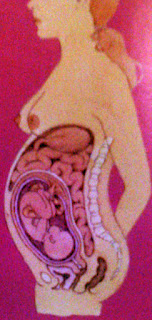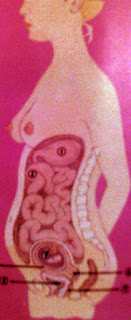 YOU AND YOUR GROWING
BABY (WEEKS 0-40)
YOU AND YOUR GROWING
BABY (WEEKS 0-40)
The first phase (weeks 0-12)
Pregnancy is divided into three phases, or trimesters. In
the first, from conception until about twelve weeks, much of the hard work of
growing a baby takes place.
WEKS 0-4E
The length of your pregnancy is calculated from the first
day of your last period. The egg (ovum) is released from the ovary in the
middle of the menstrual cycle (usually at around day fourteen). The sperm swim
towards the egg, and surround it in the outer part of one of the fallopian
tubes. Once one sperm has penetrate the egg, the egg’s surface changes to
prevent other sperm getting through, and the fertilized egg journeys on down
the tube. Six day after fertilization it has become a ball of cells that
burrows into the lining of the uterus.
Your
may begin to notice slight changes, perhaps in your sense of taste, some breast
tenderness, or feelings of nausea.
WEEKS 5-8
Major changes now occur as the blueprint for your baby is
laid down. His main organs begin to grow and the nervous system develops. The
heart begins to beat at about week six and the limbs are developing. At first
they look a bit like flippers, but gradually knee and elbow joints are formed.
The face also begins to develop and the mouth and tongue are already visible.
Many
women now notice they are pregnant. Your breasts may start to grow and
you may
feel tired and nauseous and go off certain foods like coffee and alcohol.WEEKS 9-12
 The embryo begins to look more like a baby now and is
technically called a fetus. During this time all the major organs such as the
lungs, kidneys and liver are formed. The skeleton begins to develop too. The
ears and nose can be recognized, and the eyes are forming, but still closed.
Fingers and toes are growing, and the baby even has the beginnings of external
genital organs. He is floating about in amniotic fluid, which acts as a
shock-absorber to protect him from bumps and falls.
The embryo begins to look more like a baby now and is
technically called a fetus. During this time all the major organs such as the
lungs, kidneys and liver are formed. The skeleton begins to develop too. The
ears and nose can be recognized, and the eyes are forming, but still closed.
Fingers and toes are growing, and the baby even has the beginnings of external
genital organs. He is floating about in amniotic fluid, which acts as a
shock-absorber to protect him from bumps and falls.
You may
find that any feelings of nausea begin to abate at this stage.
Your baby at week 12
Length: 3in
Weight: 1oz
1.
Stomach
2.
Intestine
3.
Fetus
4.
Uterus
5.
Bladder
6.
Cervix (neck of the womb)
7.
Vagina
The second phase (weeks 13-28)
The middle months of pregnancy are often the most
comfortable. Sickness and tiredness usually improve, your body begins to grow and
become quite rounded, and many couples feel they can make real plans for the
baby, now that the pregnancy feels firmly established.
WEEKS 13-18
Your baby now looks like a baby, but in miniature. All the
major organs begin to work, including the kidneys. Your baby makes
breathing-like movements. These are not real breathing, as the lungs will not
expand and work until after he is born.
His
finger- and toenails have formed and eyebrows and eyelashes are beginning to
grow. The baby’s skin is covered with vernix, a white greasy substance that
protects him in his watery environment. A fine downy hair also grows, called lanugos.
He still has plenty of room to move around, and many mothers notice the first
fetal movements at around eighteen weeks. Sometimes it is difficult to be sure
that it really is the baby moving. The feeling can be so tiny, and so strange,
almost like butterflies or bubbles in the stomach.
WEEKS 19-24
 By now the baby is growing hair on his head, and may weigh
around 1 lb and be about 12in long. There is still more fluid than baby, and he
can easily turn around inside you. You may notice quite large movements and
your partner or other children may be able to feel them if they place their
hand on your bare skin. The baby can now react to outside influences and you
may notice that be becomes much more active when you have a bath, or play loud
music. You may find indigestion a problem and eating small frequent meal may
help.
By now the baby is growing hair on his head, and may weigh
around 1 lb and be about 12in long. There is still more fluid than baby, and he
can easily turn around inside you. You may notice quite large movements and
your partner or other children may be able to feel them if they place their
hand on your bare skin. The baby can now react to outside influences and you
may notice that be becomes much more active when you have a bath, or play loud
music. You may find indigestion a problem and eating small frequent meal may
help.WEEKS 25-28
By now the baby weighs almost as much as a bag of sugar, around
21b, and is about 16in long. He is now laying down fat reserves under the skin,
although despite this he still looks very red in comparison to a full-term
baby. He may have definite period of rest and activity. Some babies seem to
kick and move around at the same time each day, and they then have set times
when they keep still, and possible are asleep.
His
eyes are open, and he may respond to the small amounts of light filtering
through the stretched abdominal muscles. He can suck his thumb, and may even
get hiccups. This is a strange sensation for the mother, almost as if he were
giving little regular kicks in the same place.
Your baby at week 28
Length: 16in
Weight: 2ib
The third phase (weeks 29-40)
Reaching thirty weeks often feels like being on the home
stretch; you can count the weeks until the baby arrives in single figures, and
your plans become more definite. You may look forward to giving up word as you
become bigger and need to rest more often. Listen to your body; some women are
still full of energy, and quite happy working and keeping active. Others
however, find that they need to slow down, and begin to focus their attention
on the baby.
WEEKS 29-32
Your baby is very well developed now. He can swallow, hear,
suck his thumb, recognize your voice, and, if he were born now, would have a
good chance of survival. However, the best place for him over the next few
weeks is undoubtedly inside you, where he is safe, secure and continues to
grow. He weighs over 3Ib now and may be about 18in. long.
You may
notice that the baby’s movements change as he gets bigger. He has less room to
move around now, but you may be able to identify which is a foot kicking and
which is as elbow poking. Ask your doctor to show you what position the baby is
lying in. she can guide your hands to feel the head, and trace the smooth
roundness of the back.
WEEKS 33-36
The baby continues to put on weight. He may weigh just over
5Ib and be about 20in. long. He will probably settle into the head-down
position, and gradually move down or `engage’. This happens as the lower third
of the uterus softens to become ready for labor, and the baby fits into the
brim of the pelvis.
WEEKS 37-40
Now your baby is plump, strong and ready to be born. He will
be able to breathe and suck well from birth. He could arrive two weeks before
or two weeks after your due date, so plan some things to do if you go overdue.
You will probably find that you need to rest each day and conserve your
energies for the hard work of labor. Gentle exercises and swimming will help
keep you supple. Daily relaxation sessions will stand you in good stead for
coping with contraction.
Your baby at week 40
Length: 20in
Weight:
Ib
No comments:
Post a Comment